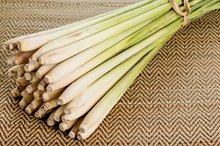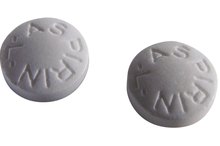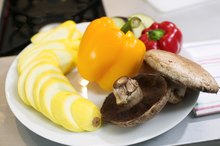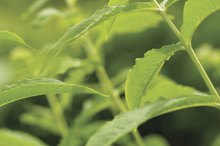Foods High in Salicylic Acid
Salicylic acid is an organic acid with anti-inflammatory properties widely used to treat acne. Aspirin, which converts to salicylic acid in the stomach, is used to treat anti-inflammatory conditions and fevers, according to a 2006 review paper published in the "Proceedings of the Nutrition Society." The paper also cites evidence that daily aspirin use may reduce the risk for developing colon cancer. Many fruits, vegetables and spices contain high amounts of salicylic acid, but according to the review, it is not certain if eating salicylate-rich foods can potentially decrease your risk of developing diseases such as cancer.
Spices
According to the "Proceedings of the Nutrition Society" paper, spices such as cumin, paprika and turmeric contain high amounts of salicylic acid. Vindaloo curry has as much salicylate as a low dose of aspirin. Other spices rich in salicylates -- values higher than 0.5 mg per 100 g of food -- include canella, curry powder, dry dill, oregano, rosemary, thyme and mustard, according to Food-Info.net, a non-profit initiative of Wageningen University in the Netherlands.
- Salicylic acid is an organic acid with anti-inflammatory properties widely used to treat acne.
- Aspirin, which converts to salicylic acid in the stomach, is used to treat anti-inflammatory conditions and fevers, according to a 2006 review paper published in the "Proceedings of the Nutrition Society."
Fruits
Garcinia Cambogia Extract Side Effects
Learn More
Fruits such as apricots, blackberries, blueberries, cantaloupe, dates, guava and raisins contain substantial amounts of salicylic acid. Granny Smith apples, fresh avocados, cherries, red grapes, fresh mandarin and fresh tangelo also contain high amounts of salicylic acid. According to the "Proceedings of Nutrition," soups made from organically grown fruits and vegetables contain higher amounts of salicylic acid compared to pesticide-treated products.
Vegetables and Nuts
According to Food-Info.net, vegetables with salicylic acid content greater than 5 mg per 100 g of food include champignon, green pepper, olive, mushrooms, tomato, radish and chicory. Other vegetables rich in salicylates include alfalfa, broccoli, cucumber, fava beans, spinach and sweet potato. Nuts such as almonds, peanuts, pine nuts, macadamia nuts and pistachios also have a salicylic acid content greater than 0.5 mg per 100 g of food.
Related Articles
References
- Proceedings of the Nutrition Society: Is There a Role for Dietary Salicylates in Health?
- Food-Info.Net: What Is Salicylic Acid and in Which Foods Does It Occur?
- Arif T. "Salicylic acid as a peeling agent: a comprehensive review." Clinical Cosmetic and Investigational Dermatology. 2015 Aug; 8:455-61.
- Arif T. "Salicylic Acid as a Peeling Agent: A Comprehensive Review." Clinical Cosmetic and Investigational Dermatology. 2015 Aug 26;8:455-61.
- Castillo DE, Keri JE. "Chemical Peels in the Treatment of Acne: Patient Selection and Perspectives." Clinical Cosmetic and Investigational Dermatology. 2018; 11: 365–372.
- Zaenglein AL, Pathy AL, Schlosser BJ, et al. "Guidelines of Care for the Management of Acne Vulgaris."Journal of the American Academy of Dermatology. 2016 May;74(5):945-73.
Writer Bio
Grace Ibay has been a freelance writer and blogger since 2005, specializing in the medical sciences and health care. She worked at Johns Hopkins University and the National Institutes of Health as a research associate and has been published in various scientific journals. Ibay holds a master's degree in health science from Johns Hopkins University in Maryland.









